Building a killer app store optimization (ASO) strategy is crucial for growing your user base, increasing retention rates, and reaching high popularity levels, all in a scalable, sustainable way.
When you need to find a new app, where do you go? Most people head right to the app store on their device, where they can find apps for everything. From fitness apps to games, there are currently over 7 million apps available in both app stores, making the competition for notoriety pretty stiff. This phenomenon puts extra pressure on us developers, who have our work cut out for us if we want our products to stand out. Developing a robust, innovative app is a painstaking process; that’s no secret.
It costs us app developers blood, sweat, and tears to deliver the top-notch products users love and have become paramount to their lives. Ok, it doesn’t actually cost blood to develop an app, but we really do spend countless hours, sleepless nights, and thousands of dollars to ensure our users always get mobile products they love and are valuable tools to better their lives. But, for this to happen, our apps have to get noticed and downloaded. Nonetheless, due to the increasingly competitive app market and the lack of optimization strategies, getting notices is becoming more challenging by the minute. So, with so much competition, how can you make sure your users actually find your app? App Store Optimization (ASO).
Regardless of how many hours and how many dollar signs you spent developing your app, your place on the top echelons of your app store of choice isn’t guaranteed. There are millions of brilliant–and others not so brilliant–mobile products that remain in the app stores for months or even years, without one single download or appearance on search results. So, irrespective of how perfect your app is or how much money you invested in it, without ASO, chances are your app will never show up on search page results, nor will it fulfill the app store ranking criterion, ending up in oblivion.
Most app developers have already jumped on the App Store Optimization train, but if you haven’t, here’s our way of helping app owners and developers effectively optimize their app page in the app stores. We at Foonkie created this article to highlight the importance of ASO and help you figure out what you can do to ensure your ASO strategy is on par with app stores’ requirements for success.

What is App Store Optimization & Why Is It Important?
App Store Optimization is a fundamental part of any mobile product’s marketing strategy. It is the science of setting in place a group of techniques or defining an approach that improves the visibility of your app in an app store’s search engine. Whether it’s on the App Store or the Play Store, implementing a robust App Store Optimization strategy can help you increase your app’s impressions and visibility. It can also help direct traffic to your online app or website–if applicable–and increase the number of monthly downloads. Thus, enforcing an outstanding App Store Optimization strategy can help you take full advantage of how Apple’s and Google’s search algorithms work. This way, you can use them in your favor to ensure your app shows up where it’s most relevant and when it’s most needed. In that sense, developers can fine-tune their app listings to efficiently rank for relevant keywords and find the right audience for their mobile product.
While there’s no denying that App Store Optimization is a great tool to ensure your app’s visibility, it does require you to have a deep understanding of the mobile application ecosystem. You must understand, study, and take into account current and upcoming trends, user stories and journeys, specific user behaviors, what your competitors are doing, and other nuances that will determine your ASO strategy and its success. And, more importantly, you must be aware of what factors impact it. Elements such as which app title you choose, its subtitle, description, icon, categories, reviews, and, more importantly, keywords are all vital determinants of whether your ASO strategy will reach success or bomb.
To simplify all the elements that makeup ASO, we can say that your App Store Optimization strategy should focus mainly on these two pillars:
- Keyword Optimization: Keywords are a crucial component of how your App Store Optimization will perform—just like in web SEO, choosing the right keywords is vital to accomplish considerable visibility and discoverability in app stores. Keyword optimization involves exhaustive research, analysis, and a thorough selection of the right keywords for your app that you must include in your app’s title, subtitle, and description.
- Conversion Rate Optimization (CRO): Conversion rate optimization is the process of adjusting an app’s product page and its visual elements to ensure a high percentage of users move from point A to point B of their user journey. In other words, CRO determines if your users are going from impressions and app store views to installs and purchases.
These two pillars work closely together to make up an App Store Optimization strategy that will result in more organic downloads, higher rankings, and increased visibility.
And although the specific algorithm that app stores use for search results is unknown, the factors mentioned above, and more, are widely known, and you can use them to try and make the algorithm work in your favor. Oh, and remember! Ongoing optimization and maintenance are also crucial to keep your app crisp and boost your app store ranking, organic installs, and traffic, all of which lead to more installs.

But Why Invest in App Store Optimization?
Before we take a plunge into how you can create your very own App Store Optimization strategy, let’s take a look at the three main reasons why we suggest you don’t overlook App Store Optimization:
ASO can improve your app’s visibility: If your app doesn’t show up on search results, how will people find it? They likely won’t. Most users will not install an app if they can’t see it. Actually, about 70% of people use their app store search bar to find new apps. In addition, around 65% of all downloads happen after performing a search, making it the most used way of finding new apps. Therefore, we can safely say that ASO is the key to preventing your app from remaining unnoticed among the sea of apps competing for visibility in app store searches. So, if visibility and high search rankings are top priorities for your app’s marketing strategy, then making ASO the cornerstone of your app’s distribution scheme is a pretty brilliant idea.
ASO can increase your app’s organic installs: Having an outstanding and expensive marketing strategy doesn’t necessarily translate to more downloads. However, ranking high on app stores and showing up on search results do. ASO can increase your app’s organic installs by boosting visibility and making your app stand out, and drawing in an influx of clicks from searchers.
ASO can increase your app’s revenue and help you save money: As mentioned above, mobile applications on the app stores can gain installs via paid ads, which can be affordable but aren’t always effective in getting meaningful downloads. On the other hand, App Store Optimization can help your app amass organic, cost-free installs product of visibility, keywords, reviews, and high ranking in search results. This way, thanks to ASO, paying for ads and downloads is a thing of the past, which will undoubtedly translate into valuable monetary savings.
Now, let’s dive right into what will hopefully become your go-to App Store Optimization checklist.
Foonkie’s App Store Optimization (ASO) Checklist
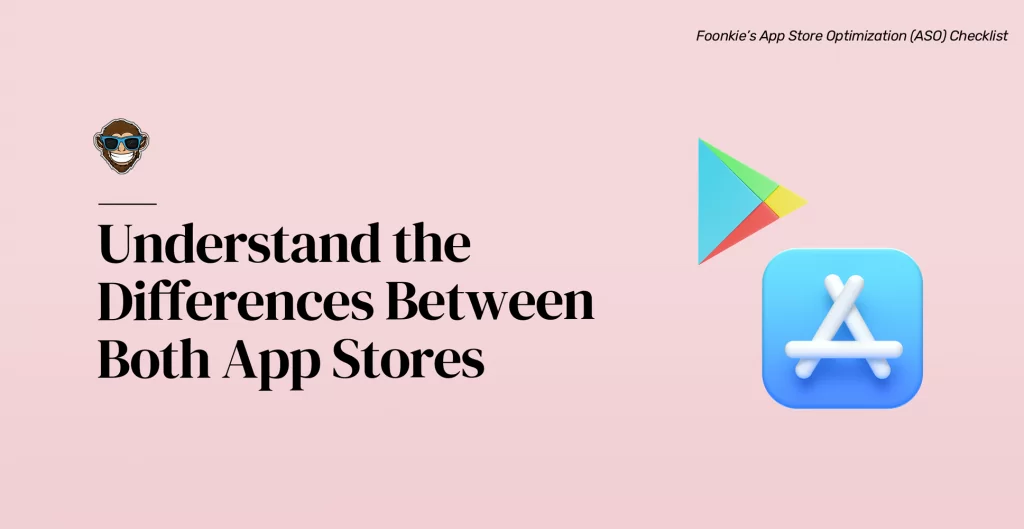
Understand the Differences Between Both App Stores
Most modern app developers understand the importance of having a presence in both app stores; henceforth, cross-platform development is becoming the norm. So, suppose you’re a cross-platform developer. In that case, you already know there are critical differences between Google’s Play Store and Apple’s App Store that require parts of your App Store Optimization strategy to be adjusted to adapt to both. Sure, both app stores have a ton of similarities. From an end-user perspective, they both operate simultaneously and serve the same purpose of being app-downloading hubs. However, each one has its proprietary system and search algorithms that require you to optimize your app.
It’s important to note that neither Apple nor Google have made public the intricacies of their app store algorithms, and they likely never will. However, some factors affect ASO differently in each app store. Therefore, you should consider them as a starting point when optimizing for either platform:
Apple App Store Ranking Factors
- App name: Apple has a 30 character limit, and search results show the app icon, title, subtitle, and screenshots or video.
- App subtitle: It has a 30 character limit and appears underneath the app title in search results.
- Keywords: Apple has a 100-character keyword limit field. Your keywords are Apple’s main ranking factor and help them decide when your app appears in the search results.
- Long description: Apple doesn’t use your app’s long description as a ranking factor. You can be creative and write about your brand and your app.
- Screenshots: You can upload up to ten screenshots. The first three are displayed on search results.
- Ratings and Reviews: This point applies to both app stores. App reviews are crucial for ranking because they are an extension of your users’ minds. The words within these reviews are highly related to your keywords. They define what your users look for in an app. Trust us; you’d be surprised by how many keywords you can mind just by examining your app’s reviews!
Google Play Store Ranking Factors
- App title: Google has a 50 character limit, and only the app icon and app title show up on search results, meaning that the title must explain the app’s purpose.
- App short description: Google allows for an 80 character limit and does not appear in search results.
- Keywords: Google’s algorithm does not rely on a keyword field. Instead, it analyses the keyword density you used in your app title, subtitle, and long description.
- Long description: Google allows you to write a lengthy description of your app that uses optimal keyword density.
- Screenshots: You can upload up to eight screenshots. However, they are only displayed on branded search results.
- Ratings and Reviews.
Keep in mind these ranking factors when you start putting together your App Store Optimization strategy. They’re essential to your app’s success in both stores and get a big chunk of those 35 billion app downloads that both platforms experienced in the third quarter of the current year.
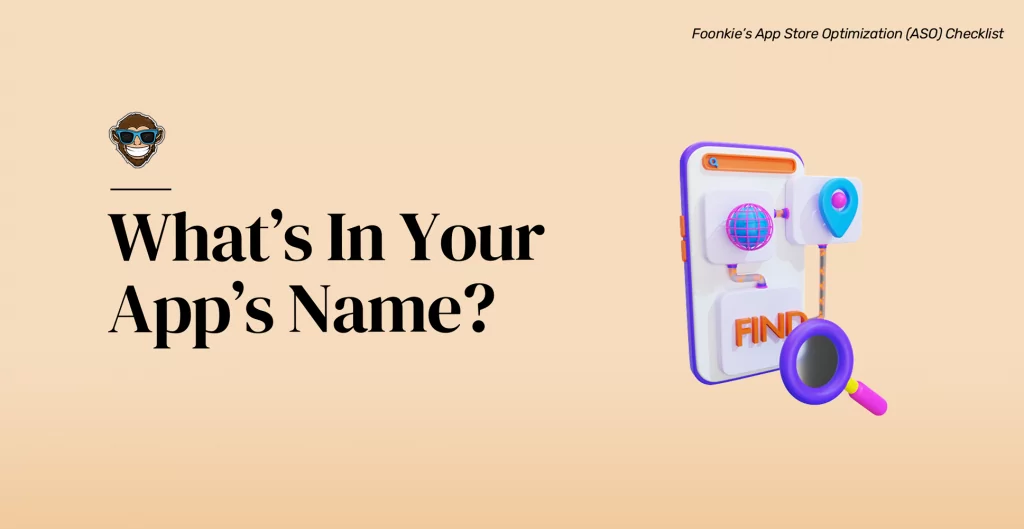
What’s In Your App’s Name?
Just like in any other field of retail, the attractiveness of any brand relies heavily on its name. Mobile products are no different. Your app’s name is not only the first thing your users will see; it also conveys your app’s purpose and what it can do for them. And, more importantly, having a good app name is a crucial part of your App Store Optimization strategy and is paramount for making your app visible in the app store search results. For this reason, you must include relevant keywords in your app name as they heavily factor into app store search results. On this point, TUNE conducted a study on the top 25 ranking positions in both app stores and concluded that apps with at least one relevant keyword in their name ranked about 10.3% higher than those without any.
Sounds complicated to condense so many keywords in a short app name? You can use your brand’s name and then a brief description of what your app does. Remember, both app stores allow for 30 to 50 characters, so you can take advantage of that number without going too crazy and insert your top keywords on your app’s title, preferably at the beginning. For instance, Amazon’s full app title in Apple’s App Store is “Amazon: Shopping Made Easy.” The people at Waze used “Waze Navigation & Live Traffic” as their app name to convey their app’s description while very slyly including a couple of top keywords. So, make sure to include all the relevant keywords you can in your app’s name while keeping it creative, unique, descriptive, easy to pronounce, and concise. Try it! It’s easier than you think.
Quick tip: Make sure you only use URL-friendly characters in your app’s name. Special characters and symbols will take away efficiency from your App Store Optimization strategy because app stores’ algorithms will refer to your app’s numeric ID, rather than its name.
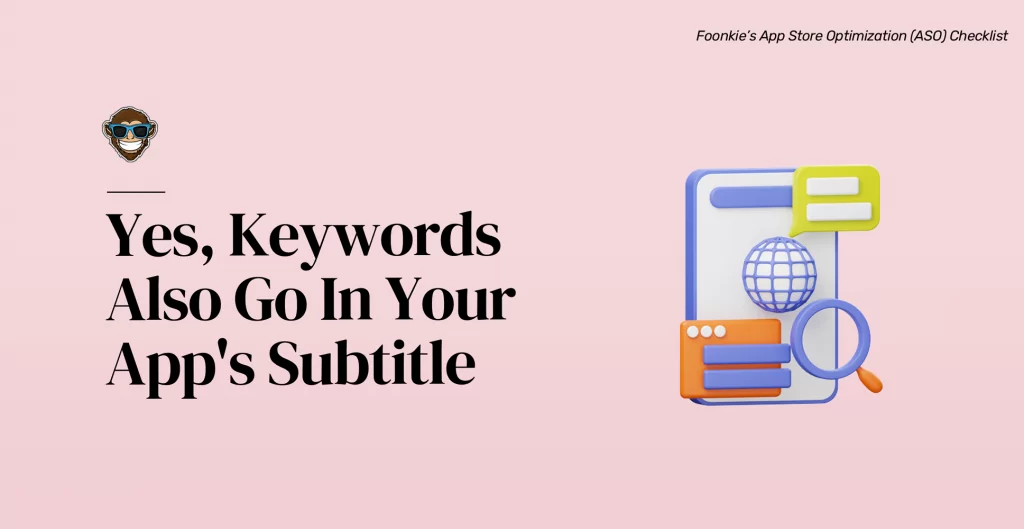
Yes, Keywords Also Go In Your App’s Subtitle
If you haven’t caught on by now, keywords are the linchpin of your ASO strategy. Using them in your app’s subtitle, in the App Store, or the short description in the Play Store is another crucial, defining factor in your app’s ranking. Your app subtitle is like an extension, or an addition, of your app’s name. In the App Store, it is usually located underneath your app’s name, and in the Play Store, it appears underneath the screenshots on your app’s product page. The subtitle is crucial because it heavily influences keyword rankings, and app stores always show it together with your app name. For instance, Duolingo’s app subtitle on the App Store is: “Learn Spanish, French, German, and more!”. As a result, it shows up right under the app name in search results and is immediately visible to users.
The terms you place on your app subtitle will influence keyword search ranks and have the second strongest ranking weight after the keywords in your app name. However, overstuffing your app subtitle with keywords won’t do you any good, quite the opposite actually. Writing an app subtitle that is nothing more than a string of random keywords will not make any sense to potential users and confuse them. Just because they are keywords doesn’t mean you should use them indiscriminately. Instead, try to use two or three keywords in an appealing, clear, and concise way to convey what your app does, complement the app name and encourage that coveted click on the install button. Oh, and last but not least. Never repeat keywords! Each keyword in your app name and subtitle will only be taken into account once, so don’t waste space repeating them and try using new ones instead.
*Quick tip: If you have a new app and your brand has no app store record or reputation, we recommend choosing keywords with low difficulty and medium-to-low popularity. This way, you won’t compete with big apps right off the bat but rather gain momentum slowly and steadily. After your app gains some popularity, you can start using high-popularity keywords and work your way up from there. *
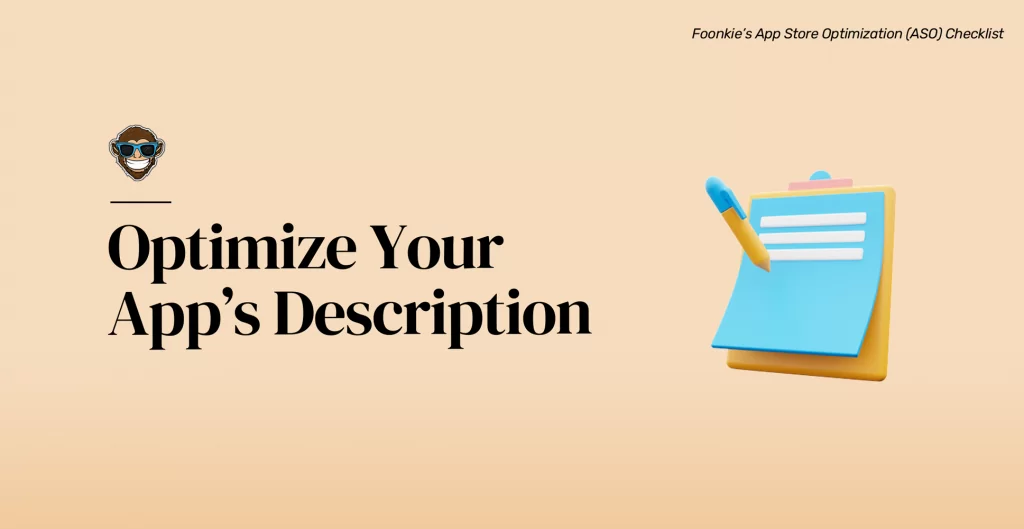
Optimize Your App’s Description
Your app’s description and the rest of your product page are the visual selling point of your product and the first thing your users will react to. As such, you should approach it with the utmost care and dedication and understand these are an essential part of establishing a clever App Store Optimization strategy. These elements are your app’s calling card and tell your potential users and the world what your app is all about. More importantly, you must renew them as your app changes with each new update making sure the description and screenshots always reflect any new features and elements as accurately as possible. You should also use simple and concise language, list your app’s benefits, and state what problems it can solve while being compelling enough for the reader to download it. You’ve already managed to convince the app store’s gatekeepers that your app is relevant enough to be featured in their platform; now, it’s time to convince your potential users that they need it in their lives.
Additionally, you should write your app’s description with your customer base in mind rather than a search engine algorithm. Yes, you should include some strategically placed keywords in your app’s description, especially in the Play Store. However, you should write your app’s description more as a call-to-action for potential customers than a keyword-riddled mess. But again, how you write your app description is inherently linked to the app store it will be displayed on. As mentioned earlier, Google Play Store uses your app’s short and long descriptions to rank for search results. Therefore, Google uses your app descriptions for ranking purposes as a crucial piece of content to index and analyze by their algorithm. Henceforth, you should include more keyword density to take advantage of the extra space and visibility. However, the App Store doesn’t use your app’s description as a ranking factor, which doesn’t mean you shouldn’t optimize it, but it gives you some leeway to be more creative without having the pressure of including specific keywords.
Last but not least, we recommend focusing the bulk of your app description on the first three lines, which are the ones that are immediately visible. These three lines will immediately grab your reader’s attention, making their decision to download your app as easy as possible by instantly communicating what your app does and why they should download it.
Quick tip: Both app stores have one crucial difference in how they factor keywords for ranking purposes. Google Play Store encourages you to repeat your top keywords throughout your app title and descriptions up to five times. However, for Apple, repeating keywords is considered a waste and doesn’t factor repetition as a ranking determinant.
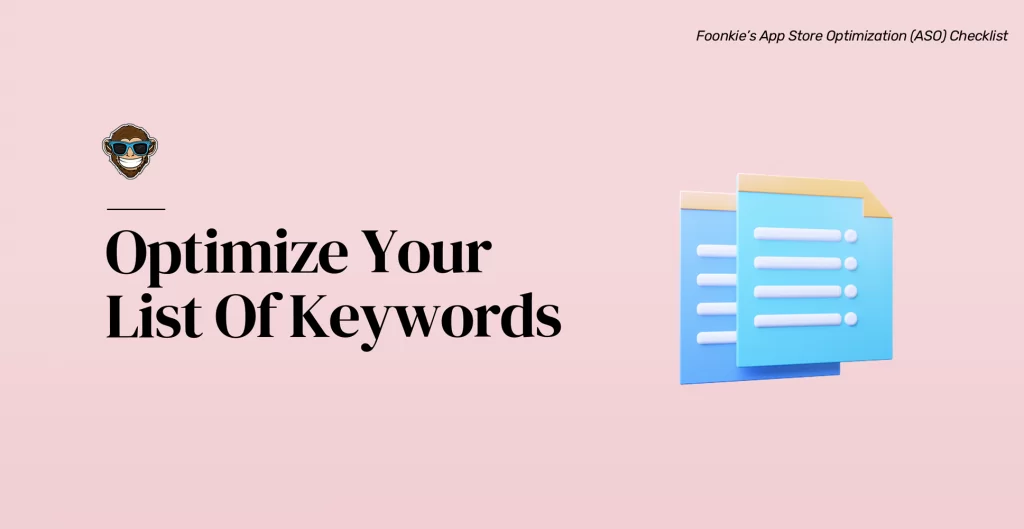
Optimize Your List Of Keywords
As you can probably infer by now, keywords play a huge role in your App Store Optimization strategy’s success. And they do! They are your ASO’s backbone. However, how you use them depends mainly on which app store you’re optimizing for. While Apple’s platform allows you to include up to 100 characters in keywords using their keyword field, Google doesn’t have this crucial feature. That doesn’t mean keywords aren’t necessary for the Play Store; they just don’t make you declare them in a specific field. Instead, Google indexes keywords inside other content elements such as your app name and description. With that in mind, whether you optimize for Apple or Google, you need to ensure you select your keywords very carefully, focusing on user research and pinpointing the top queries your customers are searching for. Remember, app store users generally use a couple of words to find apps, meaning that finding what those words are and using them as keywords is the answer to attract relevant search traffic to your app.
Now, none of these points we’ve been discussing mean you should jam as many keywords into the keyword field or your app description as possible at the expense of your ASO strategy. In fact, research has shown that the optimal number of times to repeat a keyword is five. Here, you will maximize the likelihood of achieving a prominent ranking for a particular keyword. Any more than that does not affect ASO, and you risk turning users away due to repetitive, senseless texts. In that sense, try to sprinkle your keywords of choice where they logically make sense, finding a balance between optimizing for search algorithms and your users. If your app’s product page is a hodgepodge of keywords that make sense to you but not your users, that coveted top search ranking will become useless as your customers will struggle to understand what your app does.
Quick tip: Don’t know where to start? Can’t figure out your keywords? Try starting by jotting down the main features of your app and researching the trends and high-volume searches relevant to your app category. You can use a keyword research tool, look at your user research to figure out what they’re looking for, or even analyze your competitors to get an idea of relevant keywords.
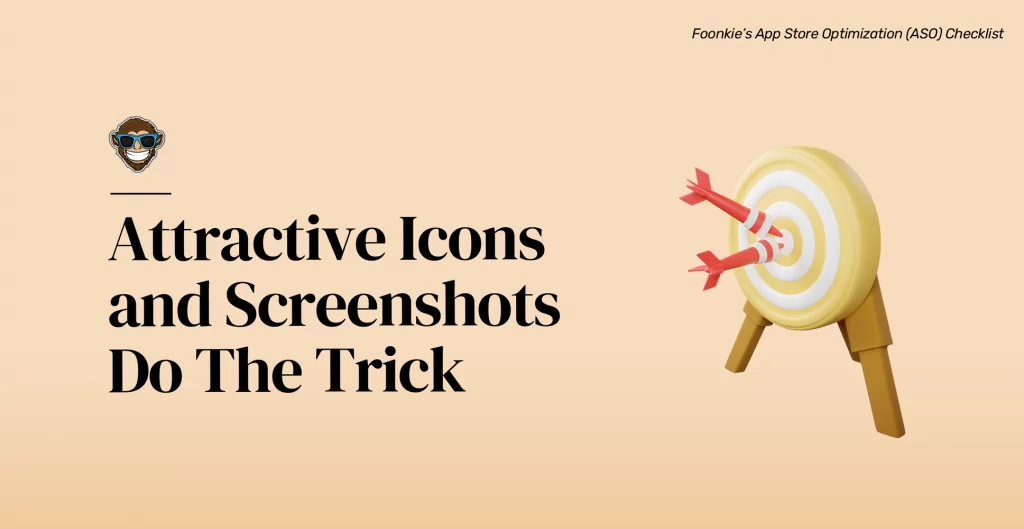
Attractive Icons and Screenshots Do The Trick
We all know visuals are one of the defining aspects that determine purchase decisions. In mobile products, your app icon and screenshots are the first visual people see regarding your product. When done right, it is an excellent opportunity to capture their attention, especially with the fierce–and growing–competition out there. Use your icon and screenshots as visual aggregates to all the other points covered in this article to convey what your app is all about in a fast, concise way. Remember, as your potential customers browse the endless sea of app options, your icon and screenshots make a crucial first impression when they stumble upon yours. Make it count!
The best, more compelling icons are the ones that don’t pack too much detail, have a clean, sophisticated color palette, contrasting colors, and relate to your app’s primary purpose and functionality. On that same note, we recommend you a drop shadow to make your app icon pop, regardless of the background. And, as usual, we suggest you do some competitive research to make sure your icon isn’t too similar to another and to check out the benchmark for apps in your category. Also, creating a random app icon, no matter how beautiful and expensive, will do nothing to attract your users.
The success of your App Store Optimization strategy also relies on your app icon design, which, once again, varies depending on the app stores. So, when approaching the design of your icon, it’s paramount to note these varying approaches and plan accordingly. For instance, you must size iOS icons to at least 1024×1024 pixels. From here, Apple will resize your icon depending on the application or context. This way, app icons can be 180×180, navigation icons can measure 66×66, and tab bar icons 75×75. So, in that sense, you must design your app icon to adapt to this resizing and manage to look still and maintain detail while scaling down or up. On the other hand, Google requires a 512×512 icon, and they have a set of guidelines that, although not mandatory, have practical recommendations on designing app icons for Android.
Screenshots, on their part, are also crucial for ASO and, along with your app icon, are the main visual appeal of your app and can be considered a graphic visualization of what you wrote on your app subtitle and description. Users expect the screenshots of the apps they’re browsing to be attractive and descriptive so they can quickly absorb all the relevant information about the app. In fact, screenshots are so crucial that in both app stores, almost 100% of users always view them when browsing. So, our advice is to use about two screenshots in the App Store and three in the Play store.
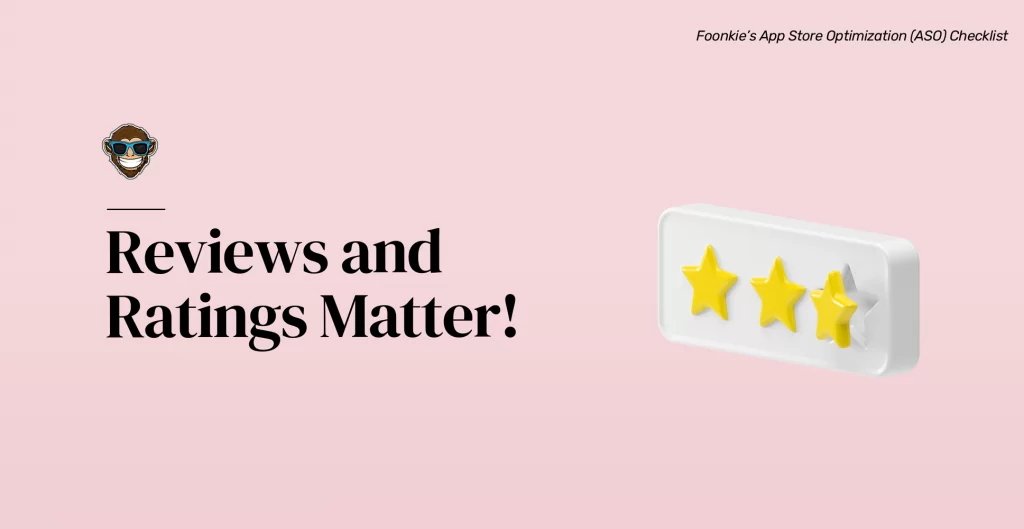
Reviews and Ratings Matter!
Both the Play Store and Apple’s App Store factor in your app’s reviews and ratings when ranking your app, meaning that the better they are, the higher your app will rank in search results. For instance, Google will comb through your app’s user feedback and find keywords hidden there to use for your app’s ranking; thus, encouraging your users to write reviews and rank your app is a failsafe way of getting ahead in the ASO game. Additionally, you can comb through these reviews to gain insight into what your users are looking for, what your app lacks, and fish out some valuable keywords.
Still not convinced? Take a look at this study that shows how app ratings and reviews can significantly impact both your App Store Optimization strategy and a users’ decision to install or pass on your app. The research shows that 50% of mobile app users won’t even consider downloading an app with a 3-star rating, a figure that drops to a staggering 85% for apps with a mere 2-star rating. Moreover, the same study found that around 77% of app users read at least one review before deciding to download an app; they will pass on it if the review is negative. In that sense, we can safely conclude that a consistent flow of positive reviews and ratings serves as validation of your app’s quality. Additionally, ratings and reviews also serve the purpose of being high determinants of rank and keyword bearers, making them a crucial aspect of your ASO strategy.
But how do you get great reviews and ratings? Well, first of all, you must have a great app. Whether technical or other, flaws in your app will only result in low ratings and bad reviews; remember, users aren’t very patient with their digital products. So, once you’ve made sure your app is working smoothly and satisfies your users’ needs efficiently, you can ask for them to provide a rating or give a review but only at the perfect moment for them to provide constructive feedback. Asking for feedback immediately after they have downloaded the app will not result in honest reviews and will likely annoy them. For instance, you can ask for a rating after the user has completed a task like finishing a telemedicine call, making a reservation, or reaching a level in a game. Also, when the time comes to request ratings and reviews, make sure to ask nicely, creatively, don’t be too abrasive, and most importantly, don’t beg.
Lastly, you can develop your own rating and feedback flow, or you can use tools like Apptentive that help you gather actionable feedback. Either way, it’s crucial to remember that replying to app reviews and feedback is paramount to maintaining a positive relationship with your users! Responding to reviews, even negative ones, shows your users you care about them and their opinions and that you’re willing to do whatever it takes to make your app their best friend. And who knows, maybe you can turn those negative review frowns into smiles!
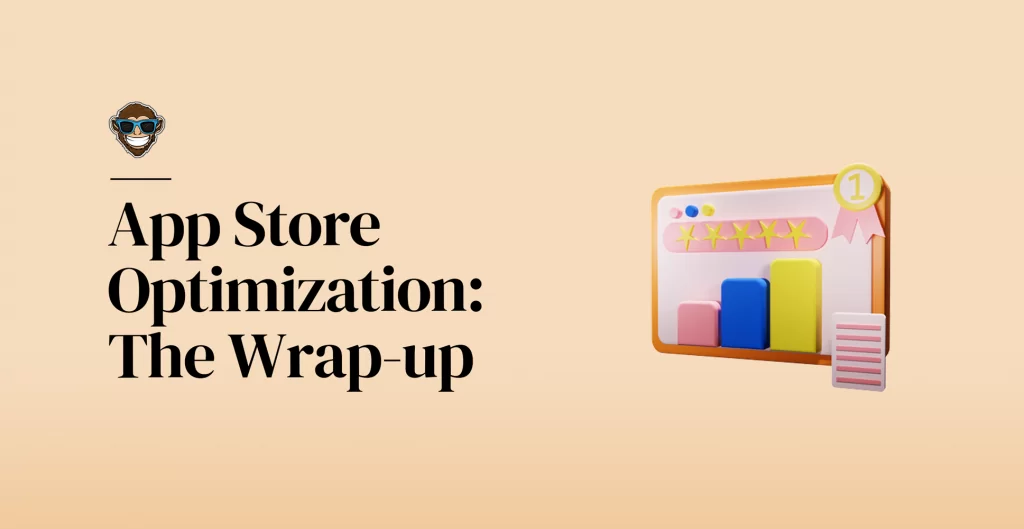
App Store Optimization: The Wrap-up
Just like any part of building your app and maintaining it, developing your App Store Optimization strategy to ensure your product’s visibility is a constantly evolving, never-ending process. It is also, sadly, an often overlooked part of many app development processes, which results in their app being lost in oblivion, costing developers millions of dollars and hours that will inevitably go to waste. In that sense, App Store Optimization is a crucial cog in your app’s entire lifecycle and is paramount for your mobile product to succeed. And do you want to know the best part? As you’ve probably inferred by now, a robust ASO strategy isn’t as hard to develop and enforce as you might have thought. In fact, you can invest as much time and money as possible and still manage to establish a solid and efficient ASO strategy for your app. You can follow this guide and adapt it to your own product one step at a time and optimize just a couple of parts, or all at once, depending on your product’s needs and how your audience responds to it. However you choose to approach ASO and implement it, the most important thing is you actually do it!
Have any questions about ASO? Need help developing your ASO strategy? Want us to build your app? We’re always available! Just drop us a line!
